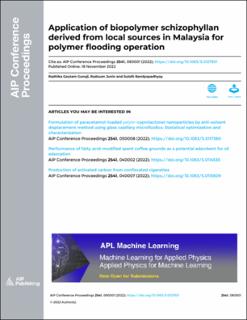| dc.contributor.author | Gautam, Radhika | |
| dc.contributor.author | Junin, Radzuan | |
| dc.contributor.author | Bandyopadhyay, Sulalit | |
| dc.date.accessioned | 2023-03-15T11:56:14Z | |
| dc.date.available | 2023-03-15T11:56:14Z | |
| dc.date.created | 2022-11-23T10:45:00Z | |
| dc.date.issued | 2022 | |
| dc.identifier.issn | 0094-243X | |
| dc.identifier.uri | https://hdl.handle.net/11250/3058368 | |
| dc.description.abstract | After the application of primary and secondary recovery methods, a significant amount of oil gets left behind in the reservoir. Thus, Enhanced Oil Recovery (EOR) methods are the only viable options. Polymer flooding has been widely used for many years. The ability of a polymer to sustain high temperature and salinity reservoir conditions, while taking into account the cost of the polymer, is a challenging aspect of its application in polymer flooding. Due to the forthcoming environmental regulation, the eco-friendly biopolymers have been gaining importance. This study aims to investigate the biopolymer schizophyllan produced utilizing locally and cheaply available sources in Malaysia for its rheological property at various range of biopolymer concentration. Also, the effect of aging at high temperature on the biopolymer viscosity was studied. A core flooding experiment was also performed utilizing a Berea sandstone core at an 80 °C reservoir temperature and a salinity of 90,000 ppm. The rheological studies showed a shear thinning behavior at all biopolymer concentrations. The effect of aging up to a period of 6 months exhibited insignificant decrease in biopolymer viscosity. Core flooding experiments using the biopolymer derived from local sources showed an incremental oil recovery of 17.25% after waterflooding. | en_US |
| dc.language.iso | eng | en_US |
| dc.publisher | American Institute of Physics | en_US |
| dc.title | Application of biopolymer schizophyllan derived from local sources in Malaysia for polymer flooding operation | en_US |
| dc.title.alternative | Application of biopolymer schizophyllan derived from local sources in Malaysia for polymer flooding operation | en_US |
| dc.type | Peer reviewed | en_US |
| dc.type | Journal article | en_US |
| dc.description.version | publishedVersion | en_US |
| dc.source.journal | AIP Conference Proceedings | en_US |
| dc.identifier.doi | 10.1063/5.0127501 | |
| dc.identifier.cristin | 2079013 | |
| cristin.ispublished | true | |
| cristin.fulltext | original | |
| cristin.qualitycode | 1 | |
